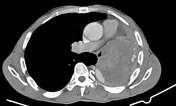Search results for “COPD”
19 results found
Case
COPD - bronchial collateral circulation

Published
15 Nov 2018
77% complete
CT
Article
Pulmonary hypertension (differential)
Pulmonary hypertension has many causes, and these can be divided in many ways. A simple and systematic approach is to proceed along the cardiopulmonary pulmonary circulation, as causes are found at each site (for a more official classification system see 2003 third world symposium on pulmonary a...
Article
Pulmonary gas embolism
Pulmonary gas emboli are a specific type of pulmonary emboli that, while rare, should be kept in mind especially with the use of automatic injectors and interventional procedures. The seriousness of the problem will depend on both the amount and rate of injected air in the circulatory system.
C...
Article
Pulmonary hypertension (2003 classification)
There are numerous causes of pulmonary hypertension, and thus not surprisingly there have been many classification systems.
In 2003, the 3rd World Symposium on PAH met in Venice and produced an updated classification system (this has been further revised in the Dana Point classification of pulm...
Article
Portal venous gas
Portal venous gas, also known as pneumatosis portalis, is the accumulation of gas in the portal vein and its branches. It needs to be distinguished from pneumobilia, although this is usually not too problematic when associated findings are taken into account along with the pattern of gas (i.e. p...
Article
Pulmonary hypertension
Pulmonary hypertension is currently defined as a resting mean pulmonary arterial pressure of >20 mmHg at right heart catheterization, which is a hemodynamic feature that is shared by all types of pulmonary hypertension.
A resting mean pulmonary arterial pressure of ≤20 mmHg is considered normal...
Article
Intravenous drug user
Intravenous drug users (IVDU) are people who inject non-medical and controlled medical drugs (and may have substance use disorder) for non-medical purposes. Frequently injected drugs include heroin, cocaine, prescription opioids and methamphetamine 6.
Terminology
More neutral terms such as pe...
Article
Westermark sign
Westermark sign is a sign of pulmonary embolus seen on chest radiographs. It is one of several described signs of pulmonary embolus on chest radiographs.
Pathology
The theory behind the sign is either obstruction of the pulmonary artery or distal vasoconstriction in hypoxic lung 3.
In one stu...
Article
Pulmonary arterial atherosclerosis
Pulmonary artery atherosclerosis is less common than systemic arterial atherosclerosis in the thorax.
It has been shown to correlate with the following factors
age
right ventricular dilatation
right ventricular hypertrophy
pulmonary emphysema
aortic atherosclerosis
pulmonary hypertensio...
Article
Innominate artery compression syndrome
Innominate artery compression syndrome, also known as brachiocephalic artery compression syndrome, is a rare cause of tracheal stenosis that occurs in the pediatric population. It is due to abnormal compression of the anterior aspect of the trachea as the brachiocephalic artery crosses it.
Diag...
Article
Penetrating atherosclerotic ulcer
Penetrating atherosclerotic ulcers (PAU) are pathologies that involve the aortic wall and along with aortic dissection and aortic intramural hematoma, form the spectrum of acute aortic syndrome.
Epidemiology
Typically, penetrating atherosclerotic ulcers are seen in elderly male patients with ...
Article
Focused Assessment with Sonography for Trauma (FAST) scan
Focused Assessment with Sonography for Trauma (FAST) scan is a point-of-care ultrasound (POCUS) examination performed at the time of presentation of a trauma patient.
It is invariably performed by a clinician, who should be formally trained, and is considered as an 'extension' of the trauma cl...
Article
Microscopic polyangiitis
Microscopic polyangiitis (MPA) is a small vessel non-granulomatous necrotizing vasculitis. It most often affects venules, capillaries, arterioles, and small arteries, although it occasionally involves medium-sized arteries.
Epidemiology
It typically affects middle-aged individuals.
Clinical p...
Article
Marfan syndrome
Marfan syndrome is a multisystem connective tissue disease caused by a defect in the protein fibrillin 1, encoded by the FBN1 gene. Cardiovascular involvement with aortic root dilatation and dissection is the most feared complication of the disease.
Epidemiology
The estimated prevalence is aro...
Case
Incidental thoracic aortic pseudoaneurysms and pulmonary squamous cell carcinoma

Published
01 Oct 2021
71% complete
CT
X-ray
Case
Aortic dissection

Published
25 Mar 2022
92% complete
CT
Article
Ehlers-Danlos syndrome
Ehlers-Danlos syndrome comprises a heterogeneous group of collagen disorders (hereditary connective tissue disease).
Epidemiology
The combined prevalence for all types of Ehlers-Danlos syndrome is estimated to be at least 1 of every 5000 individuals. There is no significant gender predominance...
Article
Hemoptysis
Hemoptysis (plural: hemoptyses) refers to coughing up of blood. Generally, it appears bright red in color as opposed to blood from the gastrointestinal tract which appears dark red. It is considered an alarming sign of a serious underlying etiology.
Terminology
A variety of clinical classifica...
Case
Pulmonary arterial hypertension

Published
28 Dec 2010
92% complete
CT
X-ray









 Unable to process the form. Check for errors and try again.
Unable to process the form. Check for errors and try again.